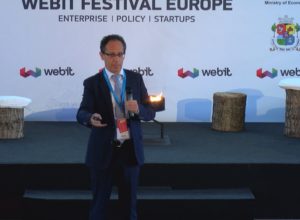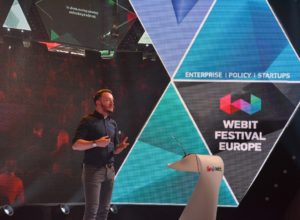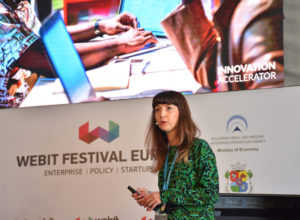We can turn societal challenges into opportunities.
The situation we find ourselves in today is very unique. There are many crises in the areas of ageing, security, health, economy, migration, food and they are all happening simultaneously. In order to solve a problem, we need to look at the bigger picture and consider how each crisis contributes to the problem in question.
At the 2017 edition of Webit.Festival Europe the Adviser at DG Connect at the EU Commission Ilias Iakovidis talked about how these crises should be viewed as opportunities for innovation and entrepreneurship. It is important to understand the NGOs and social entrepreneurs can’t cope with societal challenges on their own. This is how business opportunities arise and it is up to entrepreneurs to look for them and take advantage of them.
Demographic change has the greatest impact mostly because it happens so slowly that politicians don’t notice it. It is estimated that from 25% of the world population, Europeans will shift to representing only 4%. This is a major problem that will take its toll on people’s minds and way of living.
[caption id="attachment_5165" align="aligncenter" width="640"]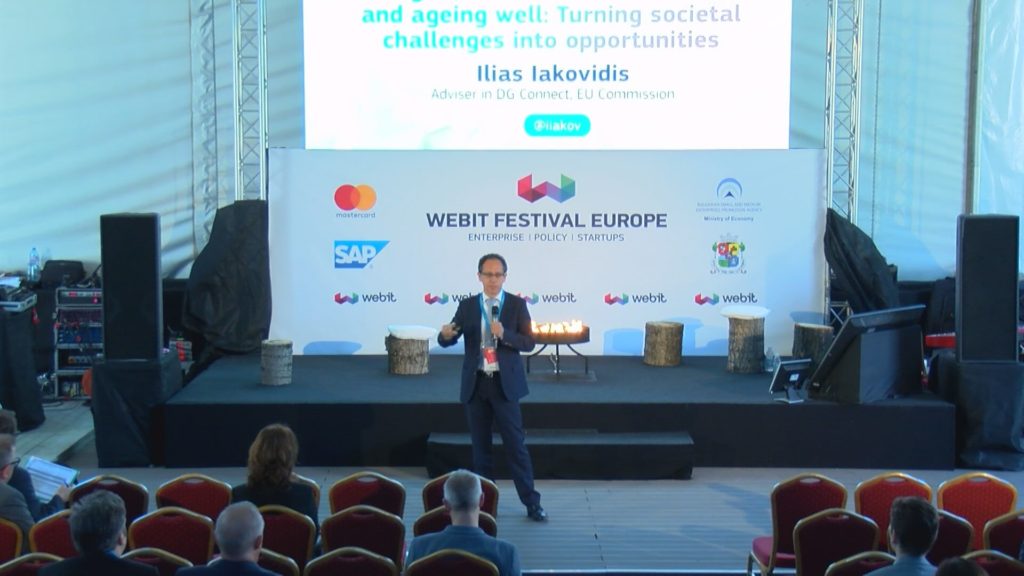 The Adviser at DG Connect at the EU Commission Ilias Iakovidis[/caption]
It is important to understand that the time of crisis is the right time to innovate. Even if we are not good at something, we should accept the challenge as an opportunity to grow. Especially when we have the infrastructure and the brains needed, the only road leads to success.
But to get to success, it is vital to know what we are doing and how exactly to do it. At some point, it is necessary to work with public administrations and the key is to understand they are not there to take care only of our issues. In fact, they have their own targets to achieve and problems to solve. If we are clever enough, we should divide the problem in parts and consult a different administration responsible for that particular issue.
The Adviser at DG Connect at the EU Commission Ilias Iakovidis[/caption]
It is important to understand that the time of crisis is the right time to innovate. Even if we are not good at something, we should accept the challenge as an opportunity to grow. Especially when we have the infrastructure and the brains needed, the only road leads to success.
But to get to success, it is vital to know what we are doing and how exactly to do it. At some point, it is necessary to work with public administrations and the key is to understand they are not there to take care only of our issues. In fact, they have their own targets to achieve and problems to solve. If we are clever enough, we should divide the problem in parts and consult a different administration responsible for that particular issue.
 The Adviser at DG Connect at the EU Commission Ilias Iakovidis[/caption]
It is important to understand that the time of crisis is the right time to innovate. Even if we are not good at something, we should accept the challenge as an opportunity to grow. Especially when we have the infrastructure and the brains needed, the only road leads to success.
But to get to success, it is vital to know what we are doing and how exactly to do it. At some point, it is necessary to work with public administrations and the key is to understand they are not there to take care only of our issues. In fact, they have their own targets to achieve and problems to solve. If we are clever enough, we should divide the problem in parts and consult a different administration responsible for that particular issue.
The Adviser at DG Connect at the EU Commission Ilias Iakovidis[/caption]
It is important to understand that the time of crisis is the right time to innovate. Even if we are not good at something, we should accept the challenge as an opportunity to grow. Especially when we have the infrastructure and the brains needed, the only road leads to success.
But to get to success, it is vital to know what we are doing and how exactly to do it. At some point, it is necessary to work with public administrations and the key is to understand they are not there to take care only of our issues. In fact, they have their own targets to achieve and problems to solve. If we are clever enough, we should divide the problem in parts and consult a different administration responsible for that particular issue.
“Innovation is not invention!”, Ilias Iakovidis said.According to him to innovate and obtain both societal and economic benefits, funding is not enough. Many people make the mistake to obsess over funding. And if the ideal for success is becoming an unicorn, then the lack of a single European market will leave many disappointed. But that doesn’t mean other opportunities don’t exist. On the contrary, they do, especially in the work with societal issues. It is all about ecosystem and in both demographic change and health we have a developed ecosystem. There are already regions putting money in this areas and entrepreneurs who work in health, smart homes, ageing and independent living should check what financial support they can receive from these regions and grab the opportunities for digital innovation. The so called silver economy creates huge opportunities for businesses. Age is a very active lead market which the EU Commission has an interest in approaching. A lot of consensus and collaboration are needed to build a successful innovation business. The creation of an ecosystem requires people to get out of their comfort zone and to even start doing things they are not very good at. But this is the only way to success. The worst thing that we witness today is scientists who are behind the invention trying to be inventors, innovators and businessmen all at the same time. The truth is, it doesn’t work that way, they have to choose to be either an inventor or a businessmen. For sure they can’t do both. You can watch his full lecture here: If you want to keep up with the latest trends in the world of digital economy and technology, then Webit.Festival is the right place for you. Visit our website and book 2 in 1 of our Super Earlybird tickets for Webit.Festival Europe 2018. Feel the Webit vibe with some of the best photos from this year’s event! [easingslider id="4954"]
Microsoft’s newly launched App enables visually impaired people to have an...
Microsoft has created Seeing AI - an intelligent app which thanks to the power of the cloud and AI working together is able to narrate the surrounding world to visually impaired people.
The scale of the impact Artificial Intelligence will have on the global labor force in the case of its mass implementation is the main topic when this technology is discussed. Nevertheless, the role AI plays in improving the quality of life of individuals is quite important and has a very positive impact on society.
Advanced AI technology used in automated vehicles can be adapted to applications which aim to help visually impaired people to navigate much better in their environment. Thanks to its ability to accurately sense the surroundings and to make quick decisions, AI can improve the life of people with vision loss by enabling them to participate more actively in the society.
Imagine the scale of the impact this technology could have considering that according to the World Health Organisation, there are 285 million people in the world who are visually impaired. 39 million of them are blind and the rest 246 million have vision loss.
Microsoft’s intelligent camera app is very easy to use - you just need to point the phone’s camera at the object or the person you want to see and then you hear information about them. By recognizing friends, their facial expressions and emotions, Seeing AI enables visually impaired people to receive information about the body language of the people in front of them, which results in a more efficient communication.
The app can be also used to read documents and to identify products by scanning the barcode. Furthermore, it can describe the environment which is surrounding the user to help them navigate better in the space. Identifying currency in the case of cash payment is a feature that Microsoft is still working on. The company defines the mission of the app as:
“Turning the visual world into an audible experience.”In order to recognize the world around it, the app uses neural networks which learn how to execute a task based on an existing example. This same technology powers self-driving cars and drones. Since the basic functions of Seeing AI are carried on the device, they can be accessed more quickly and even when the Internet connection is not very good. Only experimental features such as describing the surroundings require a connection to the cloud. The app directs the user to move the camera to the left or to the right to get the person or the object in shot. According to the tech lead on Seeing AI Saqib Shaikh, Seeing AI stands out because of the neural networks’ speed. Microsoft wanted the face recognition on a device to happen as fast as possible and they succeeded. Within milliseconds, the result is ready and the user can hear it.
“It’s all about the speed and we try to do as much as we can on the device.”, Shaikh said.Currently the app is available in US, Canada, India, Hong Kong, New Zealand and Singapore only for iOS devices. If you are interested in the latest trends in Artificial Intelligence, then Webit.Festival Europe is the right place for you. During the AI Summit, you can listen to top level speakers such as the following who have attended Webit before: the President and Global Brand Director at Havas Worldwide Jason Jercinovic, the Partner at IBM Ventures Christoph Auer-Welsbach and the CEO at CUBED Attribution Russell McAthy. Here you can get more information about Webit.Festival, while here you can get all the information you need about the tickets for the event.
The importance of Story in Storytelling and in Branded Content
The truth is everybody loves a good story. From cave paintings, through hieroglyphics all the way up to movies, stories are the tool we as human beings use to communicate and pass on information.
It is proven that the chemical makeup of the brain changes when someone tells us a story. As a result, people can align their views with these of the storyteller. This is a very powerful tool to use as a brand marketer.
At the 2017 edition of Webit.Festival Europe the Creative Director for T Brand Studio International of The New York Times Graham McDonnell shared what an important role story plays in branded entertainment. What matters is to create content people can actually engage with. Something that takes them on a journey which tells a real, human story they can relate to.
Stories follow a simple formula. First, we introduce an element which is the main thing the audience can relate to. Of course, this element should face an obstacle most often represented by the villain in the story or an internal dilemma. And the grand finale reveals the outcome, the result at the end of the story which very often is quite unexpected.
[caption id="attachment_5149" align="aligncenter" width="640"]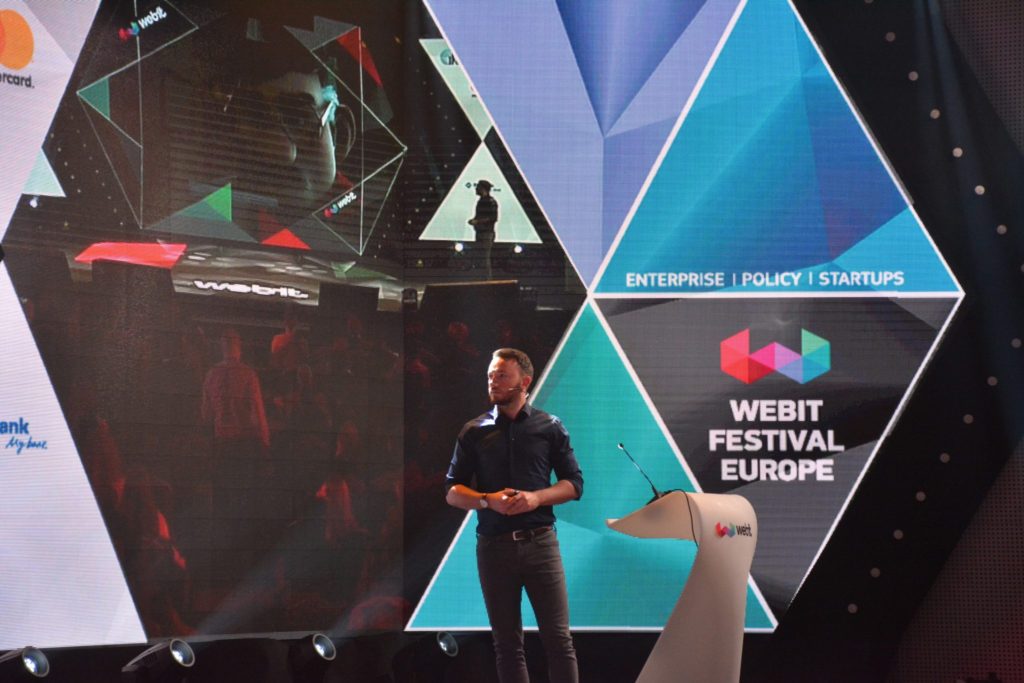 The Creative Director for T Brand Studio International of The New York Times Graham McDonnell[/caption]
When applied to brands, it is important to consider the landscape or how readers will access the content. Nowadays, the answer is on their mobile phones which according to research, people check around 10 times a day. In reality, the screen is populated with so much different content, that it is a real competition to win over the user’s attention.
The Creative Director for T Brand Studio International of The New York Times Graham McDonnell[/caption]
When applied to brands, it is important to consider the landscape or how readers will access the content. Nowadays, the answer is on their mobile phones which according to research, people check around 10 times a day. In reality, the screen is populated with so much different content, that it is a real competition to win over the user’s attention.
 The Creative Director for T Brand Studio International of The New York Times Graham McDonnell[/caption]
When applied to brands, it is important to consider the landscape or how readers will access the content. Nowadays, the answer is on their mobile phones which according to research, people check around 10 times a day. In reality, the screen is populated with so much different content, that it is a real competition to win over the user’s attention.
The Creative Director for T Brand Studio International of The New York Times Graham McDonnell[/caption]
When applied to brands, it is important to consider the landscape or how readers will access the content. Nowadays, the answer is on their mobile phones which according to research, people check around 10 times a day. In reality, the screen is populated with so much different content, that it is a real competition to win over the user’s attention.
“We need to stop interrupting what people are interested in and be what people are interested in.”, Graham McDonnell said.This is what branded content is all about. Its goal is to make the product much more easier to digest because the focus is not on the product itself but on the story it is part of. When creating a brand story a small change in the formula mentioned earlier appears. First, we introduce the obstacle and then we present the element which is there to solve the problem. Only then, it comes time for the final outcome. Stories are told all of the time and an example Graham McDonnell gave was politics, more precisely USA elections. He stressed the important role story played in Donald Trump’s election campaign. It was a very simple and effective story but most importantly it targeted the same audience every single time.
“You got to figure out the story first and then figure out how you tell it.”, McDonnell said.He emphasized on the importance of how the story is told. It is the combination between both a really good story and the way it is told that makes the entire experience. The truth is, readers can gauge very well whether something is worth their time. Content should be divided in smaller chunks and mixed with images which according to research, people process 60 thousand times faster than words. The content should be simple and relevant to the consumer. Because what matters is to engage the consumer and create relationship based on loyalty with them, which is far more important than selling the sole product. You can watch his full lecture here: If you want to keep up with the latest trends in the world of digital economy and technology, then Webit.Festival is the right place for you. Visit our website and book 2 in 1 of our Super Earlybird tickets for Webit.Festival Europe 2018. Feel the Webit vibe with some of the best photos from this year’s event! [easingslider id="4954"]
Audi transforms driving time into a personal experience with its 25th...
The 25th Hour Project of the German automobile manufacturer aims to research and understand how the self-driving cars of the future could restore the time we spend in commuting.
Autonomous automobiles are bound to disrupt the urban mobility as we know it largely due to the combination of three very important trends. Computer vision is finally good enough to recognize objects on the road and to build 3D maps of the surrounding area. A ride-sharing, self-driving model will enable companies to cut costs from hiring drivers. Lastly, electrification will make the cost of maintenance of the vehicle lower and it will benefit the environment.
Self-driving cars are expected to not only make people's lives easier, but also to make roads much safer. According to KPMG, only in the UK autonomous cars will lead to 2,500 fewer deaths between 2014 and 2030.
Currently, only some of the driver’s tasks are automated. Next year, it is expected for the car to take control on motorways while the driver is ready to take over if needed and is still required for many situations. According to the motor industry, in eight years cars should be able to drive entirely on their own with the driver only supervising the process. It is estimated that from 2030 drivers will no longer be necessary and cars will be completely autonomous.
Americans spend approximately 50 minutes a day in their car. Audi aims to take this necessity time and develop autonomous cars which will be able to convert it into productive time for work, quality time spent with family and friends or into time to relax while watching a movie or playing a video game.
Audi is still at the stage of testing how volunteers react to three major stimuli - light, sound and the frequency and density of information which is displayed on the screens in the car. Participants ride inside Audi’s simulated autonomous car which has four seats facing each other, large projection screens on all sides and no steering wheel.
The company should consider how to implement commercials in a more elegant way in its premium car range because in-car advertising is inevitable. Especially when the car’s connectivity will shape the whole autonomous driving experience. According to Audi, the car will reach its full potential only when it becomes part of a completely networked road system which will enable the automated Audi cars to communicate to each other and to the nearby infrastructure, shops and restaurants. As the head of culture and trend communication at Audi Melanie Goldmann said:
“The car is going to be the ultimate mobile device.”The car will adapt to the person using it by learning their habits and making suggestions based on the gathered information. This data collection could help turn the car into an even more productive space than the office itself. As far as privacy is concerned, Audi will store the data in the cloud rather than in the car. The research showed that productivity time is well developed and down time can be easily recreated in the car. The situation with quality time is different because it is extremely personal to each consumer. Therefore, Audi should collect as much data as possible about the life of the person in order to be able to predict and meet their needs. If you are interested in the latest news about Self-driving Vehicles, then Webit.Festival Europe is the right place for you. During the Mobility Summit, you can listen to top level speakers such as the following who have attended Webit before: the Investment Principal at the European BMW i Ventures team Sohaila Ouffata, the Regional General Manager EMEA of Uber Jambu Palaniappan and the CEO of Hyperloop Transportation Technologies Dirk Ahlborn. Here you can get more information about Webit.Festival, while here you can get all the information you need about the tickets for the event.
Innovation should be used to find a solution to world hunger
As surprisingly as it might sound, in 2017 one in every nine people is deprived from access to a nutritious meal on a daily basis.
There are different reasons behind this phenomenon. Natural disasters caused by climate change affect the most vulnerable people around the globe. One major consequence of conflict is hunger. The big conflict in the Middle East affects not only Syria, but also its neighbouring countries - Lebanon, Jordan and Turkey.
In reality, 20 million people worldwide are on the break of famine. During Webit.Festival Europe 2017 the Private Sector Partnerships and Innovation Accelerator Lead at World Food Programme Hila Cohen talked about how innovation can be used to reach the sustainable development goal of zero hunger.
The World Food Programme is a United Nations agency which delivers food to people who need it the most. Trucks, ships and aircraft supply food to 80 million people a year in the most remote locations in the world. The World Food Programme needs partners like NGOs, governments and the private sector in order to find a solution to world hunger.
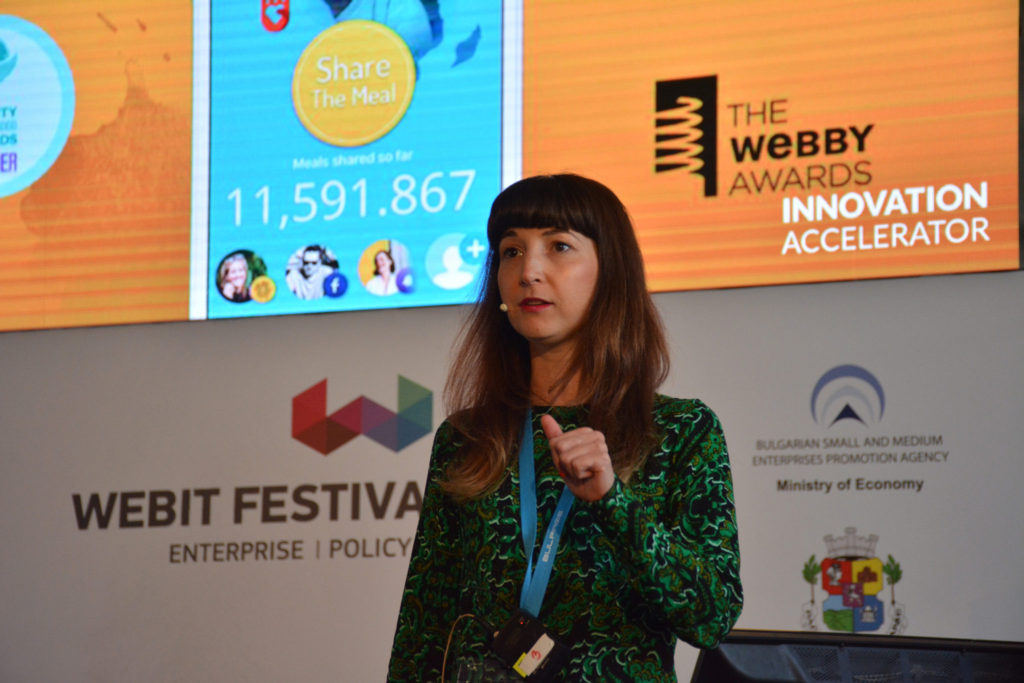 The Private Sector Partnerships and Innovation Accelerator Lead at World Food Programme Hila Cohen[/caption]
The agency has developed an app called ShareTheMeal, which takes advantage of the fact that there are more people with mobile phones than hungry people on the planet. With the app, you can donate 50 cents at a time and feed a child for a day. Up to today thanks to 50 cents donations, more than 12 million people have been fed.
Food for Tech is another project which aims to empower refugees by giving them tech skills. The idea is that these skills can be used at the current location of the refugees but also at other places they go as they migrate. The World Food Programme is looking into self-driving trucks which will be able to cope with the challenges of places where there is no real roads or a secure Internet connection.
The Private Sector Partnerships and Innovation Accelerator Lead at World Food Programme Hila Cohen[/caption]
The agency has developed an app called ShareTheMeal, which takes advantage of the fact that there are more people with mobile phones than hungry people on the planet. With the app, you can donate 50 cents at a time and feed a child for a day. Up to today thanks to 50 cents donations, more than 12 million people have been fed.
Food for Tech is another project which aims to empower refugees by giving them tech skills. The idea is that these skills can be used at the current location of the refugees but also at other places they go as they migrate. The World Food Programme is looking into self-driving trucks which will be able to cope with the challenges of places where there is no real roads or a secure Internet connection.
“Stopping world hunger is not something we can do on our own.”, Hila Cohen said.When the location of the delivery is very hard to reach, the food is dropped from the aircraft. In the case of an existing food market, a cash-based transfer is applied. People receive credit cards, a SMS system or paper vouchers which enable them to go to the market and select and buy their own food. The World Food Programme contributes to the education system’s development by introducing the school feeding concept. The idea behind it is to give food to children in schools, which would mean parents will not have to decide between sending their child to school or to work.
“Even though the world population is growing, the number of hungry people is diminishing.”, Cohen said.Regardless of this positive trend, if actions are not taken by 2030 the hungry people worldwide are estimated to be around half a billion. By opening the World Food Programme Innovation Accelerator, the agency is counting on technological innovation to help make these numbers go down. Startups related to food can receive funding and access to the field from the Innovation Accelerator. The variety of countries in which the World Food Programme operates, gives startups a great opportunity to get acquainted with a different ecosystem. [caption id="attachment_5131" align="aligncenter" width="640"]
 The Private Sector Partnerships and Innovation Accelerator Lead at World Food Programme Hila Cohen[/caption]
The agency has developed an app called ShareTheMeal, which takes advantage of the fact that there are more people with mobile phones than hungry people on the planet. With the app, you can donate 50 cents at a time and feed a child for a day. Up to today thanks to 50 cents donations, more than 12 million people have been fed.
Food for Tech is another project which aims to empower refugees by giving them tech skills. The idea is that these skills can be used at the current location of the refugees but also at other places they go as they migrate. The World Food Programme is looking into self-driving trucks which will be able to cope with the challenges of places where there is no real roads or a secure Internet connection.
The Private Sector Partnerships and Innovation Accelerator Lead at World Food Programme Hila Cohen[/caption]
The agency has developed an app called ShareTheMeal, which takes advantage of the fact that there are more people with mobile phones than hungry people on the planet. With the app, you can donate 50 cents at a time and feed a child for a day. Up to today thanks to 50 cents donations, more than 12 million people have been fed.
Food for Tech is another project which aims to empower refugees by giving them tech skills. The idea is that these skills can be used at the current location of the refugees but also at other places they go as they migrate. The World Food Programme is looking into self-driving trucks which will be able to cope with the challenges of places where there is no real roads or a secure Internet connection.
“That’s how we are dreaming. We dream big.”, Cohen said.Hydroponics is another area of interest for the agency. It enables people to grow food without soil by using water, minerals and a manageable ecosystem. The World Food Programme is testing to use the Blockchain technology to transfer money from the organisation to the people in need. You can watch her full lecture here: If you want to keep up with the latest trends in the world of digital economy and technology, then Webit.Festival is the right place for you. Visit our website and book 2 in 1 of our Super Earlybird tickets for Webit.Festival Europe 2018. Feel the Webit vibe with some of the best photos from this year’s event! [easingslider id="4954"]
